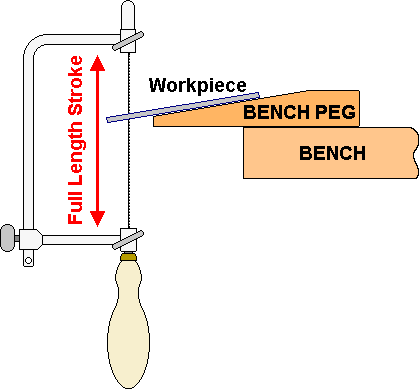Beekeeping Tools
Piercing Saw Blade Supplies
|
|
|
|---|
|
Beekeeping Tools Piercing Saw Blade Supplies |
Jeweler's 'piercing saw' |
|---|
|
A piercing saw is a small, fretsaw styled, frame saw that has fine blades intended
for cutting metal, traditionally used by jewelers, but has uses in model making and any
metalworking that requires fine detail. Piercing saws are capable of cutting other materials
including wood and plastic, although they are mainly used on metal. The piercing saw gets
it's name from the process of making 'blind' cuts or 'piercings' whereby a small hole is
first drilled through the work. One end of the saw blade is fitted into the saw frame
and the other is threaded through the hole. The open end of the blade is then clamped into the
remaining end of the saw frame. When sawing is completed, the saw blade is unclamped from
one end of the frame and withdrawn form the work.
Piercing saws have a frame with pinch clamps that will grip the blades, handles are usually turned wooden ones like the one illustrated. Saw frames are available with throat depths that vary from 50 mm to 200 mm, But if greater throat is required then a fretsaw frame can be pressed into service which extends the range to 450 mm. The saw illustrated is a photograph of my own, which has a sliding adjustment to cope with differing blade lengths, this also helps in that broken pieces of blade can be used up. The sliding action of this feature is also used to tension the blade rather than the more normal method (described below) that is applied to fixed frames. The saw blade is fitted into the thumbscrew clamps with the teeth facing towards the handle. The blades are fragile and are caused to cut on the pull stroke so that the blade is held straight by the extra tension due to teeth resistance rather than buckling as it would tend to do on a push stroke. The magnified portion of the blade shows a brown colouration due to copper plating which inhibits rust and also acts as a minor lubricant when cutting hard steel. Main lubrication is by pulling the blade from end to end across a block of beeswax which lubricates the cutting and renders the cutting action quieter and 'sweeter to the feel'. Household toilet soap can also be used in this fashion and sometimes leads to less clogging when sawing copper or aluminium. I have also used motor oil on some occasions (but this is messy). Petroleum jelly (vaseline) will sweeten the cutting of some zinc based die casting alloys. |

|
|---|

|
A 'bench peg' is a chamfered wooden block that can be mounted either above or
below the edge of a work bench. It is used as a rest for drilling and grinding operations,
or when filing and sawing.
When filing and sawing it can be useful to gain a little more control by filing or sawing both the work and the edge of the peg at the same time. It can sometimes be helpful to have a 'keyhole' shaped slot in the front edge of the bench peg so that the work is well supported and the blade itself is in 'free space'. |

|
|---|
|
The illustration shows the saw reciprocating in an exact vertical plane, however
it sometimes can be more prudent to use the saw perpendicular to the work. Thick solid sections are
easier to saw if the blade is perpendicular as the amount of material presented to the
blade is a minimum, but very thin sections can be more easily sawn at an angle as more
teeth are then in contact with the work, which reduces juddering or 'chatter'.
Using the full length of the blade on every stroke, cannot be over stressed, it is the single most important factor in blade life, although skill and rhythm that is developed by practice also go a long way towards saving blades. |

|
|---|
Dave Cushman.
Originally written by Dave Cushman. Edited by Roger Patterson.
Page created 21/01/2004
Page updated 14/11/2022